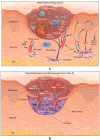Advanced Growth Factor Delivery Systems in Wound Management and Skin Regeneration
- PMID: 28749427
- PMCID: PMC6152378
- DOI: 10.3390/molecules22081259
Advanced Growth Factor Delivery Systems in Wound Management and Skin Regeneration
Abstract
Growth factors are endogenous signaling molecules that regulate cellular responses required for wound healing processes such as migration, proliferation, and differentiation. However, exogenous application of growth factors has limited effectiveness in clinical settings due to their low in vivo stability, restricted absorption through skin around wound lesions, elimination by exudation prior to reaching the wound area, and other unwanted side effects. Sophisticated systems to control the spatio-temporal delivery of growth factors are required for the effective and safe use of growth factors as regenerative treatments in clinical practice, such as biomaterial-based drug delivery systems (DDSs). The current review describes the roles of growth factors in wound healing, their clinical applications for the treatment of chronic wounds, and advances in growth factor-loaded DDSs for enhanced wound healing, focusing on micro- and nano-particulate systems, scaffolds, hydrogels, and other miscellaneous systems.
Keywords: chronic wound; drug delivery system; growth factor; wound healing.
Conflict of interest statement
The authors declare no conflicts of interest.
Figures


Similar articles
-
Advances in drug delivery systems (DDSs) to release growth factors for wound healing and skin regeneration.Nanomedicine. 2015 Aug;11(6):1551-73. doi: 10.1016/j.nano.2015.03.002. Epub 2015 Mar 21. Nanomedicine. 2015. PMID: 25804415 Review.
-
Delivery of growth factors for tissue regeneration and wound healing.BioDrugs. 2012 Jun 1;26(3):163-75. doi: 10.2165/11631850-000000000-00000. BioDrugs. 2012. PMID: 22500904 Review.
-
Stem cells and growth factors-based delivery approaches for chronic wound repair and regeneration: A promise to heal from within.Life Sci. 2021 Mar 1;268:118932. doi: 10.1016/j.lfs.2020.118932. Epub 2021 Jan 2. Life Sci. 2021. PMID: 33400933 Review.
-
Instructive microenvironments in skin wound healing: Biomaterials as signal releasing platforms.Adv Drug Deliv Rev. 2018 Apr;129:95-117. doi: 10.1016/j.addr.2018.03.012. Epub 2018 Apr 5. Adv Drug Deliv Rev. 2018. PMID: 29627369 Review.
-
Nano-drug delivery systems in wound treatment and skin regeneration.J Nanobiotechnology. 2019 Jul 10;17(1):82. doi: 10.1186/s12951-019-0514-y. J Nanobiotechnology. 2019. PMID: 31291960 Free PMC article. Review.
Cited by
-
The Role of Electrospun Fiber Scaffolds in Stem Cell Therapy for Skin Tissue Regeneration.Med One. 2019;4:e190002. doi: 10.20900/mo.20190002. Epub 2019 Feb 15. Med One. 2019. PMID: 30972372 Free PMC article.
-
Healing Mechanisms in Cutaneous Wounds: Tipping the Balance.Tissue Eng Part B Rev. 2022 Oct;28(5):1151-1167. doi: 10.1089/ten.TEB.2021.0114. Epub 2022 Mar 11. Tissue Eng Part B Rev. 2022. PMID: 34915757 Free PMC article. Review.
-
Cellular therapeutics and immunotherapies in wound healing - on the pulse of time?Mil Med Res. 2024 Apr 18;11(1):23. doi: 10.1186/s40779-024-00528-5. Mil Med Res. 2024. PMID: 38637905 Free PMC article. Review.
-
Adipose-derived stromal cells for nonhealing wounds: Emerging opportunities and challenges.Med Res Rev. 2021 Jul;41(4):2130-2171. doi: 10.1002/med.21789. Epub 2021 Feb 1. Med Res Rev. 2021. PMID: 33522005 Free PMC article. Review.
-
Effects of Rutin on Wound Healing in Hyperglycemic Rats.Antioxidants (Basel). 2020 Nov 13;9(11):1122. doi: 10.3390/antiox9111122. Antioxidants (Basel). 2020. PMID: 33202817 Free PMC article.
References
Publication types
MeSH terms
Substances
LinkOut - more resources
Full Text Sources
Other Literature Sources

